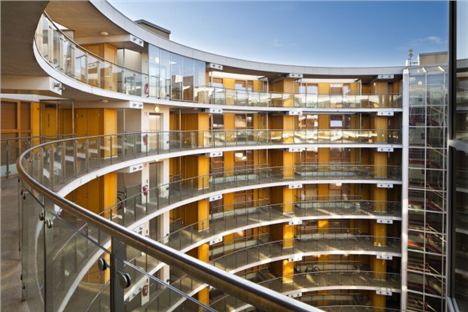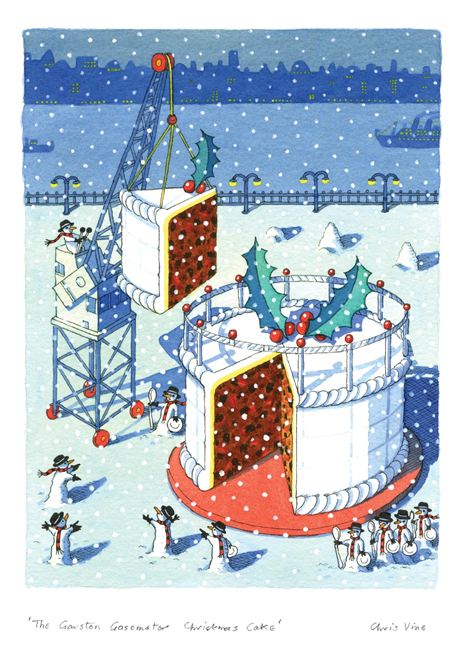It has dominated the Garston skyline for decades, and figured in a dramatic World War II bomb incident, but the gas-holder that has towered over the old village will soon disappear.
National Grid has lodged a planning application with the city council to dismantle the two gas-holders at Garston Gas Works.
But could Garston learn a lesson from Dublin where a similar structure has been transformed into a landmark on the Irish capital’s skyline?
The old gas-holder in Ireland, built in 1895, now provides 200 apartments in a nine-storey block.
Encased within the metal cylinder, each flat has outside views and inner windows overlooking a central courtyard.
Aigburth town planner Erin Walsh, who divides her working life between Merseyside and Dublin, said: "The Garston gas-holder is a familiar and well liked landmark on the local skyline. It is a great pity to see it go. It would have been wonderful to see somebody come forward to replicate the much admired scheme in Dublin.
 'Great example of imagination': Dublin's gasworks was transformed into flats
'Great example of imagination': Dublin's gasworks was transformed into flats
“All it takes is imagination and many things from the past can enjoy a fresh lease of life. The Dublin Gas Works is a great example of imagination and commitment to developing the Dublin's former industrial character.”
Nevertheless, the vast majority of gas-holders have been demolished, thanks to the arrival of natural gas in the 1970s, coupled with modern piping and distribution technology. Garston’s sleeping beauty will be the next to bite the dust.
Dismantling work is expected to start in the spring of next year and take up to nine months to complete, releasing the site for housing development as part of the Garston Village Plan.
 Chris Vine's Garston gasometer cake
Chris Vine's Garston gasometer cake
Consultants to the National Grid recognise the prominent impact on the skyline of the bigger 65m diameter gasometer, but say it does not represent a notable example of this type of gas-holder construction and, as such, has limited significance from a heritage perspective when compared with those elsewhere. The smaller holder, about 46m in diameter, contains no prominent features. Both structures are redundant, isolated from the gas network and have already been purged of gas.
The report to the council says the main heritage reference in Garston is the adjacent Grade II Listed church and grounds.
“In this regard the Garston Village Masterplan recognises the benefits of removing the holders to develop the site and better reveal the adjacent Grade II listed church,” say consultants.
Explaining the decision to demolish the gas-holders, the consultants say they no longer serve an operational purpose, in terms of gas storage, and make no other positive contribution to the environmental setting of the local area.
The structures, they add, cannot feasibly be used for any other purpose.
The conclusion: “Vacant structures of this nature represent a security and safety risk in addition to being a financial, environmental and social liability. In which case there is little practical alternative but to dismantle the holders.”
Alex Corina, well known artist in Garston and south Liverpool, says the gas-holder and the neighbouring church are important landmarks for Garston.
In 2008 he commissioned a series of works to celebrate Liverpool’s year as European Capital of Culture. That project saw artist Chris Vine create a Christmas card, using Garston’s gasholder as a Christmas cake.
“The gasworks has become a natural oasis for wildlife. It is part of Garston’s history, something we see every time we drive through the area.”
The man who thwarted the Hun
 Harold NewgassIn 2011, there was a call for a World War II lieutenant to be honoured locally. The aptly named Harold Newgass single-handedly saved Garston from obliteration in November, 1940, by defusing a land mine that landed in the gas works.
Harold NewgassIn 2011, there was a call for a World War II lieutenant to be honoured locally. The aptly named Harold Newgass single-handedly saved Garston from obliteration in November, 1940, by defusing a land mine that landed in the gas works.
He worked for two days in dank and dirty conditions inside one of the gas cylinders after a parachute mine landed in it but failed to explode. Homes for miles around the works were evacuated and up to 6,000 people displaced. Lt Newgass was awarded the George Cross for his bravery.















